The Best Fascia Stretching and 7+ Exercises
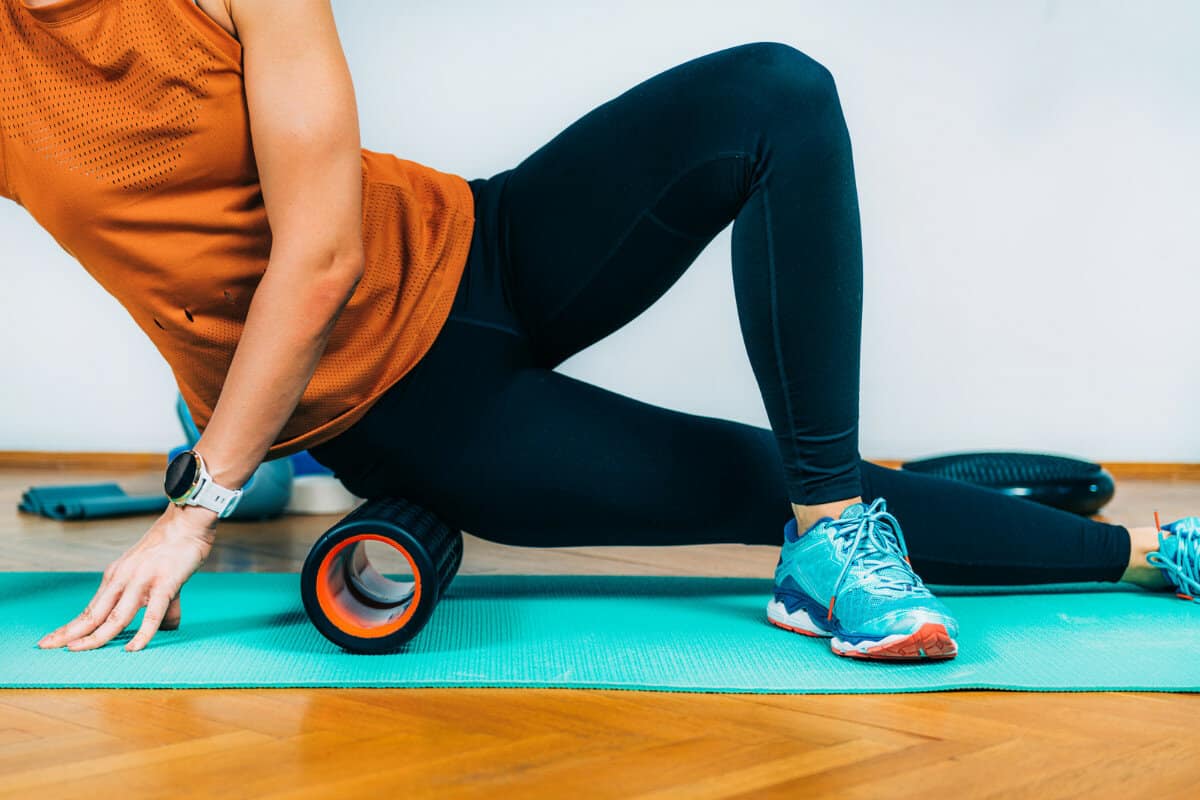
Have you been looking for a way to relieve tightness or soreness in your body? Fascia stretching might be just what you’re looking for! Read on to learn all about this powerful form of physical therapy and how it can help you reach your fitness goals.
*This article contains affiliate links. They don’t cost you anything, but if you make a purchase after clicking, we might receive a small commission to help us keep writing more great articles.
What Is a Fascia?
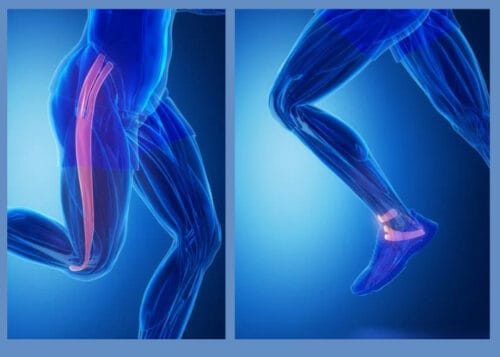
The fascia exists throughout your entire body– it’s a network or band of connective tissue that provides a structure for and supports your muscles, bones, and organs.
It also helps you transfer force from one body part to another. So when your fascia gets overly tight, as in the case of an injury like plantar fasciitis, it can become pretty painful to move. Since an estimated 10% of the population will develop plantar fasciitis during their lifetime or inflamed fascia in the foot, fascia stretching can offer tremendous benefits.
What Are the Benefits of Fascia Stretching?
Even if you’re not suffering from a tight fascia, starting a fascia stretching routine can benefit your body and prevent injuries. Here are a few of our favorites.
- Move better: Fascia stretching can improve your mobility, flexibility, and range of motion.
- Feel better: You can feel relief in painful and tight areas where your fascia might be damaged.
- Improved circulation: Since your fascia connects all parts of your body, stretched fascia helps everything flow better and speeds up the healing process. It also helps to break down scar tissue.
- Less tension and stress: Fascial stretch therapy releases tension in your muscles and joints, which means you’ll experience improved posture and less stress.
How Do I Stretch My Fascia?
In today’s world, many of us can have a relatively sedentary lifestyle, which often results in the shortening of the fascia. So just a gentle stretch of the right muscles can provide substantial relief for sore muscles or extraordinary insurance against new injuries. Though the fascia runs throughout the body, certain areas, including our feet, hips, neck, and shoulders, tend to get especially tight and often need the most stretching.
But what is fascia stretching, exactly? A fascia stretching protocol can include exercises we usually associate with regular stretching. Considering that the fascia spans through our whole body, you’re technically stretching your fascia any time you’re stretching anything. But here are a few basic stretches for wellness.
Hip Flexor and Back Stretches
Hip flexor stretches can be as simple as standing up on one leg, grabbing the opposite foot, and putting it behind you for about 15 seconds up to one minute. Then switch to the other side. It’s quick, simple, and provides great relief after sitting at a desk all day.
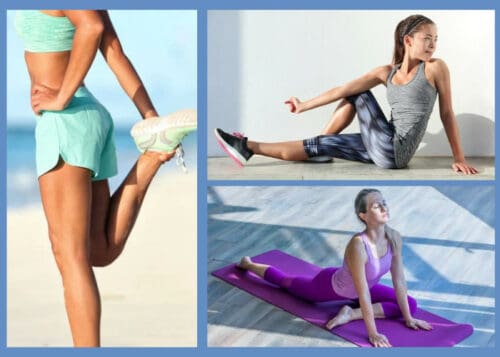
The pigeon pose is an excellent way to stretch the back and hip flexors. Sit on the ground with your left leg folded in front and your right leg stretched out directly behind you. With your hips square, lean into the stretch as far as you can. Repeat on the other side.
Sit on the ground with your legs straight out in front of you. Bend your left leg and bring your left foot to the right of your right knee. Twist your torso and bring your right arm to the left of your left knee. Stretch for about 30 seconds and repeat on the other side. You should feel a great stretch in your back and glutes.
Runner’s lunges are also extremely helpful for stretching your hips, back, calves, and feet. Have your left leg behind you on the ground and your right foot up in front of you (like the photo directly below.) Stretch your hip forward, trying not to let your knee go in front of your foot. For an extra stretch, twist your left arm towards the right side of your body. Repeat on the other side. You can also do a standing runner’s lunge with your back foot on the ground. The standing version of this stretch will help stretch out your foot and calf as well.
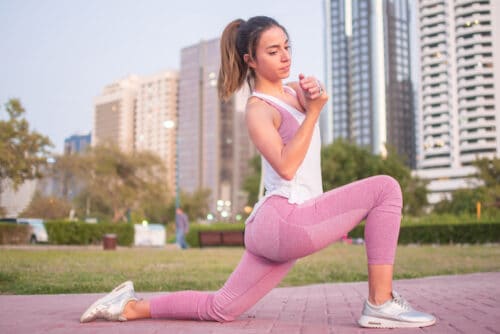
Foot and Calf Stretches
Your feet are a relatively small area on the body but often get the most wear and tear from physical activities, so stretching fascia tissue here can prevent injury caused by an active or sedentary lifestyle. Many of these stretches are relatively simple, but it’s helpful to stretch both sides of your foot, so your fascia can contract and stretch.
An easy stretch is, with legs together in front of you and bent, sit on your feet with your toes pointed for one to two minutes. You should feel some therapeutic stretching from your shins down to your feet. Then flex your feet and sit on your toes. You can see the flexed example below.
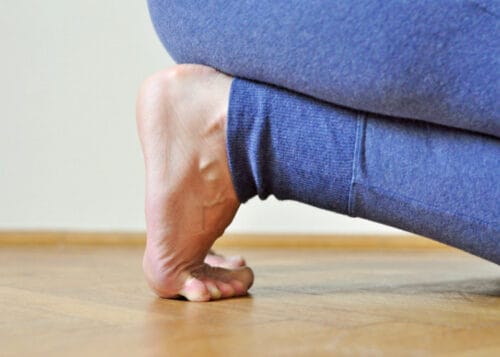
Stand on a stair with the balls of your feet on the step and heels hanging off. Feel the stretch in the back of your calves as your heels hang down towards the floor and hold for about 15-30 seconds. Be sure to hang on to the wall or railing if you don’t have great balance.
How Do You Release Tight Fascia?
If you have tight calf muscles, tension in your neck and shoulders, or general muscle pain throughout your entire body, you probably have some tight fascia. The general exercises will work on the injured body parts as well, but a physical therapist, chiropractor, or another medical professional might be able to recommend some targeted exercises for pain relief. They might also recommend professional massages or more intensive physical therapy.
Also, be sure to keep your body in balance. If, for example, you have plantar fasciitis in your right foot, you probably also want to do the same fascial stretch in your left foot as a precaution. That way, you can also help prevent injury on the other side.
What Are Some Tools to Help With Fascia Stretching?

While you don’t necessarily need to spend money on tools to help stretch your fascia, here are a few tools that can help your stretches.
- Frozen water bottle: roll a frozen water bottle under your sore foot for about 15 minutes. It’s fantastic therapy after a run or when your feet are incredibly sore.
- Tennis ball: this is ideal for targeted stretches. You can roll it under your feet or stand against a wall with a tennis ball under your back. Rolling it under any muscle knots can provide fantastic relief and stretch the compressed fascia. Lacrosse balls also work, but they’re a bit harder.
- Spiky massage ball: For a bit more targeted relief for tight fascia in your feet, this little ball provides a deeper therapy to stretch out your feet. You can also use it on your back in the same way you’d use a tennis ball.
- Gua sha: A steel gua sha tool helps to stretch and break down scar tissue in overly tight areas throughout your body. While you could probably get some relief using jade or stone gua sha you’d use for your face, we recommend a longer steel tool that’s designed for physical therapy for maximum comfort. For deeper relief, use it with this body oil and magnesium lotion from VegOut organics.
- Foam roller: Quality foam rollers can help provide relief throughout your body. Start by rolling it under your calves, work out any hot spots, then move it gradually up to your shoulders. It provides extraordinary physical therapy benefits.
- Foot massager: The Cloud Massage Shiatsu Foot Massager can significantly benefit those with tight fascia in their feet and calves. It also massages your calves, giving you deeper relief and stretching.
Extra Fascia Stretching Tips
Be patient! You’re not going to reverse significant damage to your fascia with one or two physical therapy sessions or exercises. But consistent fascia stretching will help your body feel better. Don’t feel
Your diet can also play a role in your overall fascia health. Consuming anti-inflammatory foods can help reduce inflammation throughout your body. Less inflammation means significant relief for your fascia, joints, and muscles. Scientists are also beginning to study the effects of an anti-inflammatory diet on pain relief, though more research is needed. Preliminary findings indicate that a diet based on whole foods can supplement a healthy fascia stretching program. So there’s yet another reason to eat nutritious foods!
What are your favorite fascia stretches? Any extra tips? Let us know on social #getfamilyapp!





